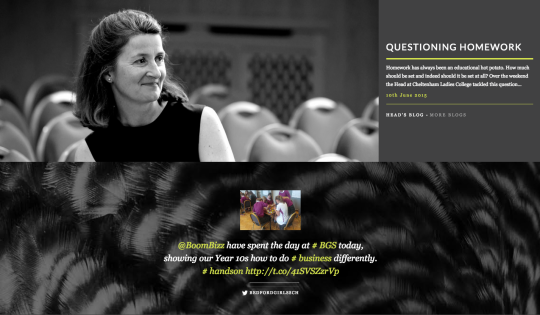““There is no greater agony than bearing an untold story inside you.”
”
Streaming your stories as they happen
Nov 2, 2015 12:01:54 PM / by Interactive Schools Blog posted in meerkat, periscope, social media
Why Don’t Parents Take Time to Understand Social Media
Oct 19, 2015 4:58:31 PM / by Interactive Schools Blog posted in social media
Social media is constantly changing, and NOT just amongst the younger generations. One moment a certain platform is insanely popular, then it falls into obscurity the next.
It seems like parents have a challenging time trying to keep up with all the shifts.
And rightfully so.
But then there are others that completely ignore the networks all together. Maybe they are on Facebook, but anything more than that doesn’t get a second look. Meanwhile, their children are bouncing from platform to platform all around the web.
What is it that makes parents stay in one spot (and resistant to dive in and learn more)? Why don’t parents take the time to fully understand social media?
Well, there seems to be a few reasons we hear about a lot! But are these justifiable reasons, or just excuses to avoid the inevitable change that every generation needs to tackle head-on?
[EXCUSE 1] Parents do not have the time
Ask any parent, and they all have their own views, values and ideas in raising their child. There is no magic formula. We learn from past generations, but past generations themselves are not equipped to advise on the new generation.
Parents must provide (first and foremost) for every need and cater to their children's various desires. This means spending each day working, cleaning, cooking, supporting, and loving just to meet the child’s basic needs.
Bold and Innovative Ways to Use Social Media in Lessons #EducationDay
Oct 13, 2015 3:19:33 PM / by Interactive Schools Blog posted in social media, Pinterest, Twitter, learning, snapchat, facebook
People mistake social media for socialising. WRONG. People do socialise on social media, but that's just a tiny part of how we use social.
Social is used for learning, collaboration, productivity, writing, curation, entertainment, storytelling. Not just socialising with friends.
Students natively use social media to communicate, curate, and share ideas online.
As teachers, this gives you a great opportunity to increase their passion for learning. Giving access and implementing strong educational resources is a great way to engage students both inside and outside the classroom.
It’s important to incorporate your lesson materials using this new medium. It reaches students through a medium they use everyday. And it also chronicles all the tips, lessons and answers you provide in your stream.
Finding bold and innovative ways to use social media is a great way for your school to progress into this new generation. These are just a few ideas that you can infuse social media into your lesson plans to.
Using Snapchat for Quizzes
Schools are seriously misunderstanding Snapchat, and how people use it. Snapchat is trying to replace TV. It understands that people are moving away from tradition television into YouTube, Netflix, and other mobile channels.
Big media companies (Sky, Daily Mail, National Geographic) have set up their own channels on Snapchat because they understand that's where people are spending their time looking for entertainment.
Because of Snapchat's ephermal nature, teachers can use it for memory quizzes. Simply set the time (1-10 seconds) that you want the image or video to appear, and publish your story to Snapchat.
Should my school be using Pinterest or Instagram?
Oct 9, 2015 9:33:34 AM / by Interactive Schools Blog posted in social media, Instagram, Pinterest
Many schools haven’t branched out past core communication platforms like Facebook and Twitter. And this leaves many of the most popular content channels untouched by school marketers.
People migrate to new networks all the time. And if your school is interested in keeping their attention, then they need to migrate with them.
It’s time to start embracing the future.
Places like Instagram and Pinterest can provide a lot of opportunity for schools to increase engagement among prospective families, pupils, and current parents.
The constant developments in the online world makes it important to embrace new channels as they emerge. This isn't to mean you should just start using them - but certainly to understand them
It’s the only way to keep up with pupils and continue engaging them in an online forum with inspiring stories.
People are Turning to Visual Platforms
We live in a very visual world, and young people are leading the revolution.
The success of visual-focused social media networks proves the trend. And–if for no other reason–that’s why you should invest resources into visually appealing content.
Why Are Schools Scared of Snapchat?
Sep 17, 2015 8:00:00 AM / by Interactive Schools Blog posted in social media, snapchat
Ah, Snapchat.
It’s full of funny, inappropriate, disappearing photos. In just a few seconds, you can communicate an important message, then have it disappear the next. No wonder kids love using it so much!
In an age where your digital footprint leaves a legacy, Snapchat provides a way to communicate without the worry of future repercussions.
Unfortunately, schools are getting crippled by fear. This is causing them to fall further and further behind in technology awareness and understanding of teenage behaviour.
But why do schools feel so afraid of Snapchat? What’s causing them to turn their backs on a channel that has gained so much popularity among students? Well, it really comes down to one main reason...
Don’t Know How to Use It
Teenagers have this innate ability to understand then adapt to the slang, context, and culture of new social channels. Most schools and educators don’t have that same ability.
A lack of fully understanding the platform leads to fear. Fear that you won’t do it right; fear that something will go terribly wrong; fear that you’ll cause a huge problem for the entire school. And so, it seems better to not use it than to use it wrong.
The Power Of School Stories
Sep 3, 2015 10:23:20 AM / by Interactive Schools Blog posted in social media, Twitter, Flickr, youtube, vine, snapchat, facebook
“We owe it to each other to tell stories.” – Neil Gaiman
From a very young age people are taught such infamous childhood fables as The Boy Who Cried Wolf, The Hare and the Tortoise and The Goose that laid the Golden Eggs.
These fables originate from 620BC and are still taught in schools today!
How many still remember these famous fables? Almost everybody will remember at least one of these infamous fables.
Storytelling began on cave walls and has travelled through time passing through rock art, hieroglyphics, painted artefacts, and has now entered the modern era with social media.
Snapchat, Facebook, Twitter, Vines have stories captured and shared every day. Storytelling hasn’t changed - but the channels we tell them via have evolved.
(The Hare and the Tortoise 1700-2015)
5 ways for schools to engage with parents on social media
Jun 17, 2015 1:25:16 PM / by Interactive Schools Blog posted in social media, Twitter, blogging, facebook
Great things happen when parents get involved in their child’s education. Not only does the school benefit from the support, but research shows [1] that it even helps academic achievement.
Unfortunately, traditional forms of parental engagement (e.g. Parent-Teacher conferences or sending a note home) don’t make much of an impact these days.
And yes, you can blame the Internet for this disruption.
These traditional methods still add some value. But that number is waning as more of the population becomes dependent on digital communication. Things like Facebook and Twitter aren’t restricted to the younger generation anymore.
Getting active on social media platforms gives your school unparalleled access to parental engagement. It’s time to embrace this powerful technology. Are you ready?
1. Reach Out to Parents
First things first, make sure to let the parents know about your social media plans. Send a letter home or shoot off an email blast with an announcement of this new engagement strategy.
It’s about getting them involved. Your efforts won’t go very far if you don’t let parents know your intentions. Getting them informed from the beginning helps ensure the success of your social media efforts for the school.
How schools are ALREADY doing this:
Haberdashers’ Aske’s School for Girls uses beautifully designed HTML email newsletters to send parents updates with what is happening - their latest news, photos, videos, tweets.
These dynamically pull through from their content/social channels. You mean to say they don’t spend hours putting this all together? That’s right. 10 mins. Max.
Notice at the bottom: connect with us.
This is parent engagement.
Every school goes on trips. What makes yours so different?
May 20, 2015 5:12:16 PM / by Interactive Schools Blog posted in social media
Every school goes on trips. Every school does sports. Every school has concerts. But what is it that makes your school different?
How do you reflect the personality, the culture, the ethos, the values of your school? You do this through storytelling.
We’ve visited hundreds of schools around the world. On the face, many are the same - for example, a co-educational independent school for 3-18 year olds.
- A school that provides an exceptional education.
- One that develops well-rounded individuals.
- A school that nurtures individuals.
- A traditional school, with a modern approach.
We’ve heard it all before.
But when we come and actually visit the school, we see how different you all are! It’s not until we get through the door that we see what makes you unique - the buildings, the pupils, the staff, the people, the ethos, the personality.
There’s always something unique that sticks with us - that makes us remember you.
By sharing photos, videos, you get a much more authentic and true view of the school. Parents love it because they get to see photos and videos of their children. Prospects love it because it shows opportunity.
You, as the marketer, can’t be everywhere all of the time. But there must always be something exciting happening! All you need is one department to start sharing their stories for it to take off.
It’s a perfect way for people to get a feel for the school before visiting.
How have you started to tell your school’s story? Tweet us @intSchools, email us, phone us, write us a letter to let us know. Whatever you fancy.
Do you need help telling these stories? Let us know, and we perhaps we can come and train you and your staff?
Creating a CTA on Facebook
Mar 18, 2015 5:20:19 PM / by Interactive Schools Blog posted in social media, facebook
Facebook’s call-to-action button helps drive traffic to your school website. But not many people know about it or how it can drive people to contact you, to download your app, to watch your video.
The button sits at the top of your Facebook Page and offers visitors an action to take.
Page admins can select from a group of CTA buttons — like Shop Now or Sign Up — to add to the top of their Page.
The seven calls to action available are:
- Book Now
- Contact Us
- Use App
- Play Game
- Shop Now
- Sign Up
- Watch Video
A few are not relevant for schools - Play Game, Shop Now. And the clearest CTA that works for schools is ‘Contact Us’.
- Book Now - book an open morning, or visit to the school
- Contact Us - contact the school
- Use App - download the school app (if there is one!?)
- Sign Up - sign up to an open morning, or a newsletter
- Watch Video - watch a marketing video
There are many uses for most of the available CTAs. However, with any CTAs, it has to attract the end person.
Book Now, Use App, Sign Up may not be clear to people. They may not understand what will happen if they click on the link. What am I booking? What app will I be using? Signing up for what?
The following examples will use Contact Us as the chosen CTA.
Step 1: When you’ve logged into your Page, as an admin, you will notice the ‘Create Call-to-action’ button. Click this to start.
What the WhatsApp acquisition by Facebook means for schools' marketing
Feb 25, 2014 4:17:00 PM / by Interactive Schools Blog posted in social media, Tech, whatsapp, facebook
Hey, what’s up? I’m sure you have heard all about Facebook’s recent purchase of WhatsApp for $19 billion (£11.4bn). It sounds a little crazy, right?
WhatsApp is a free (for the first year, $0.99 per year after that) messaging service. It is a mobile only service, that replaces the need for SMS. So really, WhatsApp doesn’t make much money, if any at all. Why then would Facebook pay $19 billion for it? That’s $42 for each of the app’s 450 million users. And the cost of running this service isn’t cheap.
The reason Facebook has bought it is primarily for two reasons:
- It has a huge number of young users
- It is mobile only
With Facebook’s recent pursue of Snapchat for $3 billion, it is clear that they are trying to own young people’s smartphone usage.
Facebook know that can’t be the number one social utility on people’s smartphones, without the help from other startups. It isn’t like Facebook cannot develop WhatsApp, or Snapchat, or Instagram - they can (and have tried!).
The problem Facebook has is that people, and in particular young people, will always be on the look out for new, cooler ways to socialise with their friends.
Another problem Facebook has is that adults tend to follow young people. Often, teens are often the early adopters, and adults are the late adopters.
This means that there is almost a cycle with social media usage:
- Young people adopt
- Adults adopt
- Young people find something new
- Adult usage plateaus
- Overall usage declines
What does this all mean for schools and their marketing?
Simply put, schools need to think similar to Facebook when it comes to their marketing. This means being alert to new social channels, and reacting quickly to trends.
It also means to always look to the future. Facebook has a huge number of users - bigger than any other social media platform, by far. But that doesn’t mean it will always be the case.
Kids move rapidly when it comes to social utilities. That will never change. And we also know that adults will often follow teens when it comes to social channels.
What kids use today, adults will use tomorrow.
Are you using it as part of your schools’ communication strategy? Let us know in the comments. Or tweet us @intSchools.










